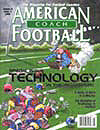Article CategoriesAFM Magazine
|
Editing Systems: Getting What\'s Right for YouHave you ever had a video session with your team and spent a large portion of it fast-forwarding and then rewinding, trying to find a specific play? When you were fast-forwarding, did you have to guess where the play was? This sort of wasteful guesswork can be eliminated with the help of a video editing system.by: Rod Smith © More from this issue ADVANTAGES OF EDITING SYSTEMS Using an editing system will not only make your video sessions run more smoothly but also allows you to easily scout your opponent and your own team - not to mention helping you teach and grade out players. You'll save time by watching only the essential video clips, because an editing system allows you to customize videotapes to your team's needs. You can create separate tapes for offense, defense and special teams. Imagine the benefits of sending scout tapes home with your players so they arrive at practice already knowing what the opponent's favorite formation is. Or giving your coaches customized tapes so they can get their grading done at home. LINEAR vs. NON-LINEAR There are two types of video editing systems available today: linear and non-linear. While programs around t....The full article can only be seen by subscribers.
|
|
|||||||
| HOME |
MAGAZINE |
SUBSCRIBE | ONLINE COLUMNISTS | COACHING VIDEOS |
Copyright 2025, AmericanFootballMonthly.com
All Rights Reserved





